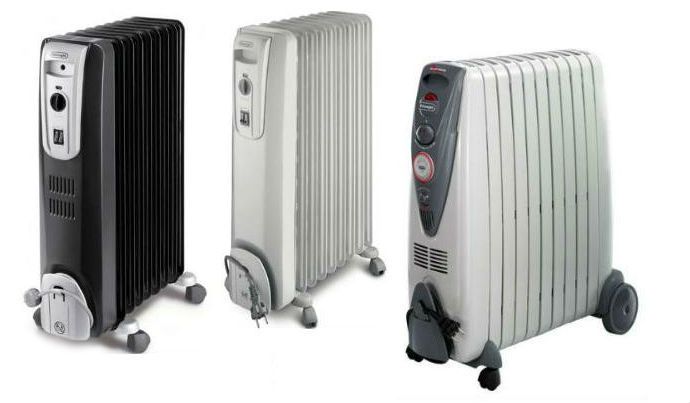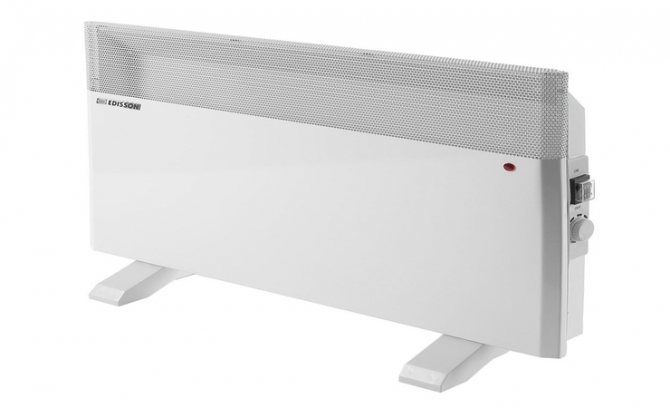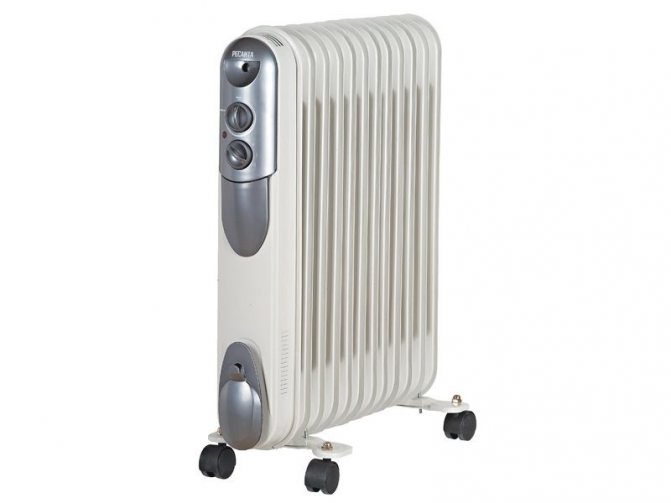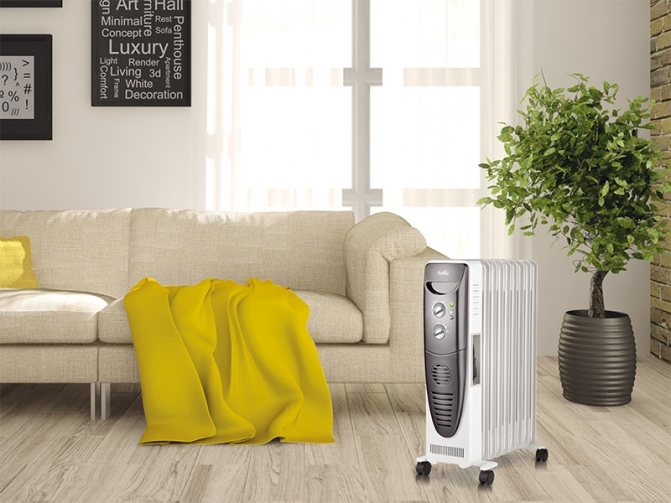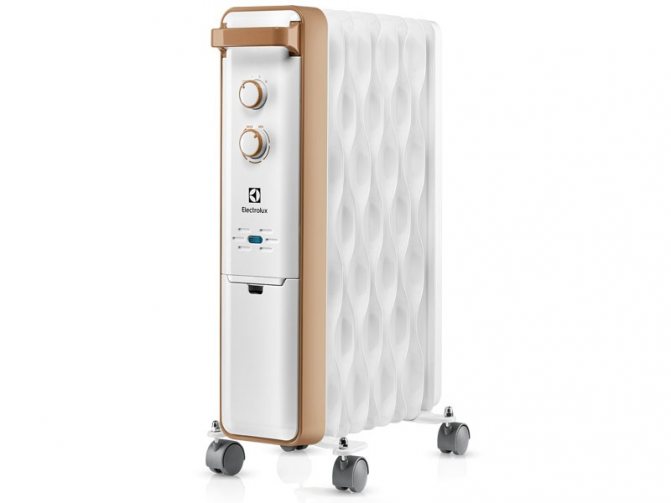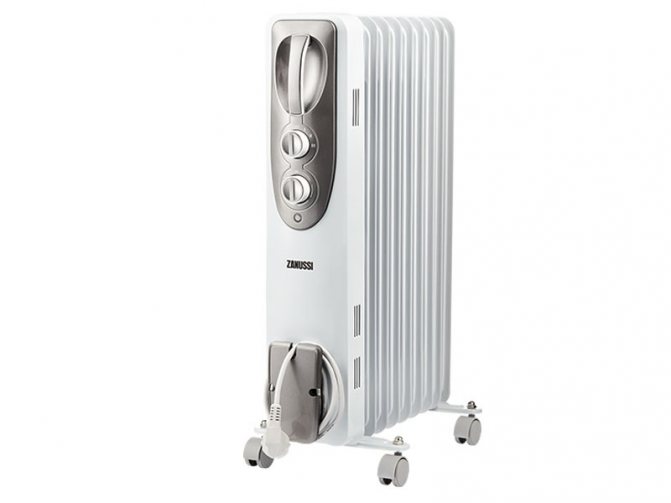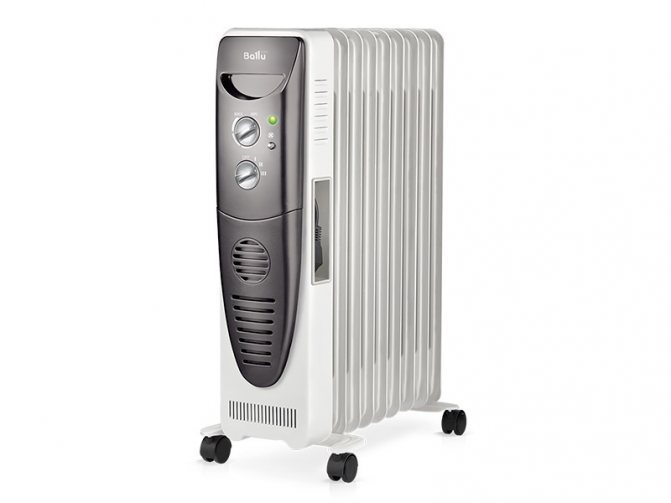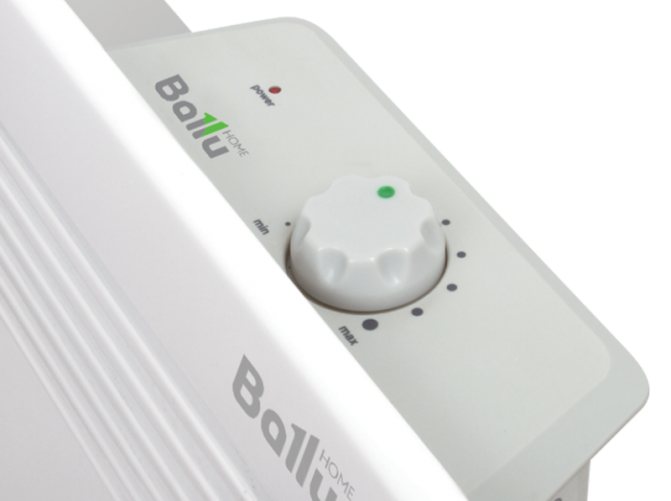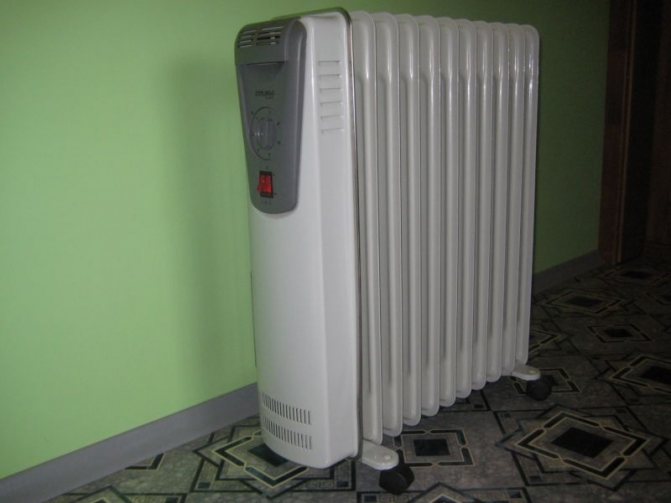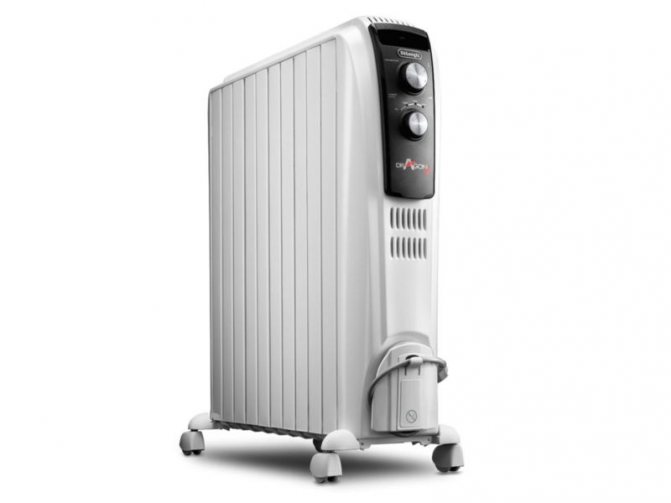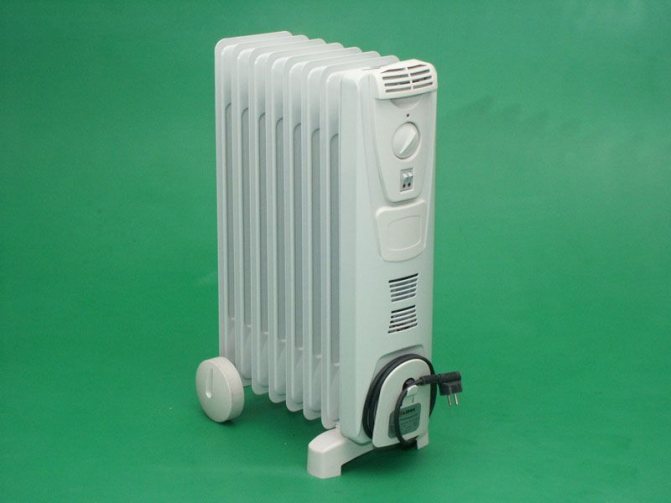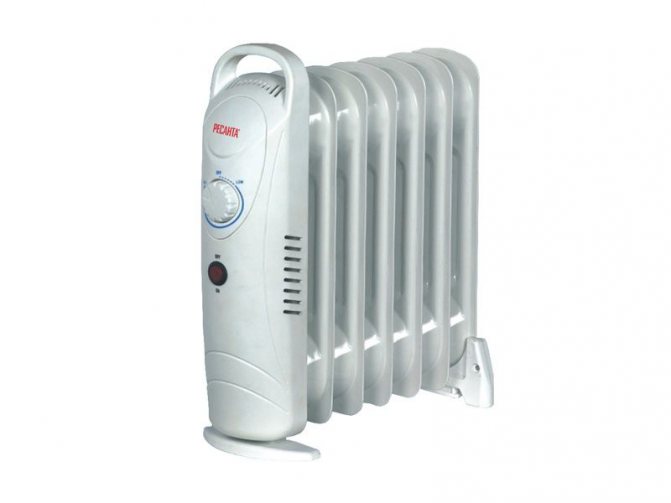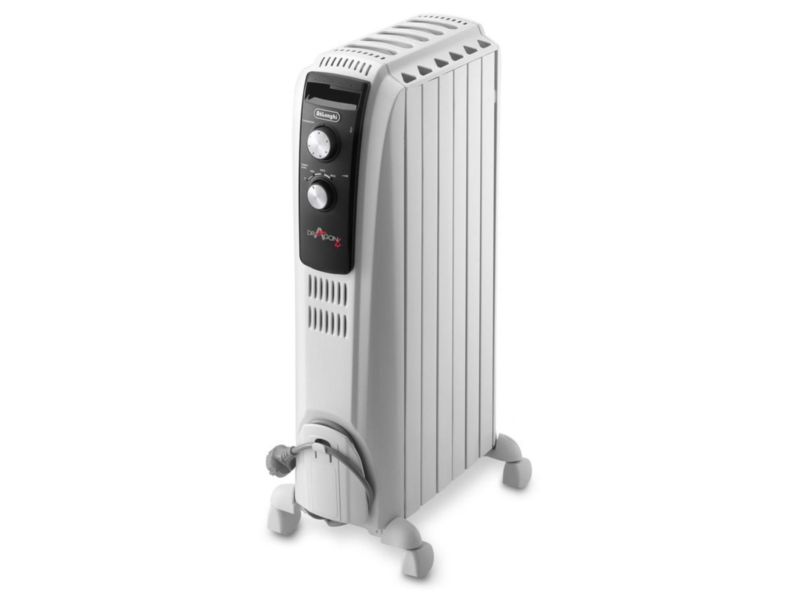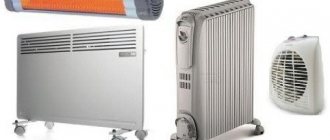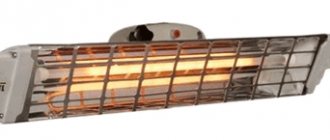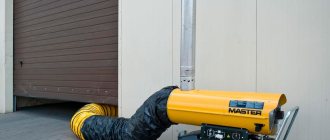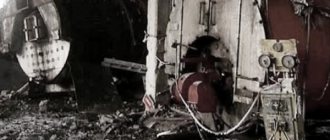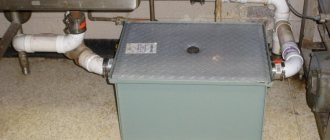The device and principle of operation of the heater
Comprises:
- oil tank;
- electric heater;
- control unit.
When a tubular electric heater (heating element) is heated, heat enters the oil, and it gives off heat through the metal body to the air. The reservoir can be constructively:
- lamellar;
- sectional.
The lamellas have a small thickness, it is convenient to place them on the walls. When compared with sectional ones, they have less power. This is explained by the smaller area.
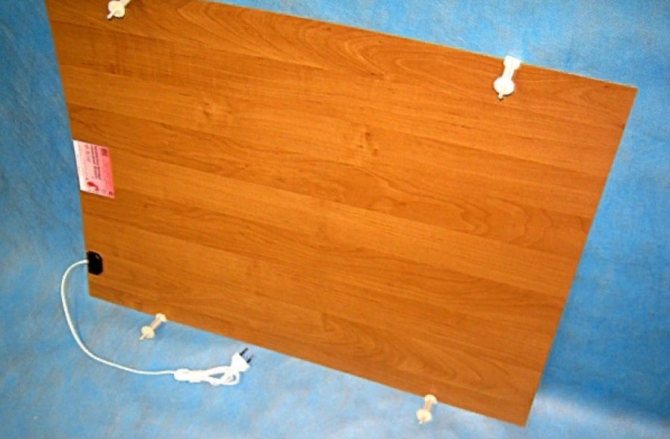
Plate heaters can be matched with furniture
Sectional ones are large, you can install a fan to increase heat transfer. Refers to outdoor. Legs or castors are used for support. The advantage is fast heating. The sections create convection - air mixing, circulation allows faster, more even heating of the surrounding space.
Elements:
- fuse;
- thermostats;
- signal lamps;
- switches.
Power regulation, rollover protection, emergency valve can be provided.
Principle of operation: when voltage is applied to the electric heater, heating occurs. Heat is transferred to the oil. It expands, becomes lighter, rises up. In its place comes the cold, heavy. It turns out a cycle.
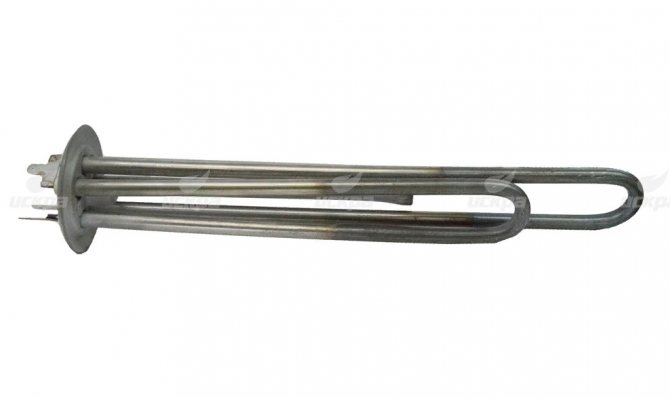

Heating element with two spirals
An adjustable thermostat is attached to the plastic cover for adjusting the case temperature. The bimetallic plate, upon reaching the set temperature, opens the power contacts, de-energizing the heater. When the temperature drops, the plate will cool down and turn on the contacts. Some heating elements have two spirals, they are connected via key switches located on the body.
Do not cover the ventilation holes on the case, this will lead to incorrect operation of the equipment.
For protection against overturning, a device is provided - an eccentric movable contact that opens when the radiator is tilted. Overheating protection - thermostat, there is a button to turn it on again, or an emergency valve. The electric heater will not turn on so that the owners are warned of the malfunction.


Electrical circuit diagram
Convector type heaters
At the first glance at heaters of this type, their flat and even body shape catches the eye.
Most often, such heaters are supposed to be fixed to the surface of the walls, but there are also floor-standing options. Moreover, the latter are equipped with swivel wheels for easy movement around the room. Some models can be wall-mounted or floor-mounted. The so-called plinth convectors look interesting, which are very low in height (from 15 cm), but their length can reach 1.5 meters.
The required temperature level in the room is maintained by means of a thermostat. In contrast to the considered oil devices that emit heat, convectors heat the room by moving air flows of warm and cold air. There are holes in the lower and upper parts of the convector body. Having heated up from the heater, warm air is discharged outside through the holes in the upper part of the case, and instead of it a new portion of cool air comes from below. Thus, due to the constant air circulation, the premises are heated. At the same time, the operation of the convectors is practically silent, and the room heats up quite quickly.
The convector mounted on the wall practically does not take up space in the room and does not interfere with movement on it, which is especially important if there are small children in the family.In addition to options for the home, you can find convector heaters for offices and industrial premises on sale.
Classification of oil coolers
Features of the electric heater:
- profile;
- material;
- power;
- installation method.
The profile is made of metal with a thickness of 0.8-1 mm. Sectional heaters are welded from separate sections, ribs give them rigidity and strength. They can work as a convector if a fan is installed. Material:
- aluminum;
- steel;
- bimetal.
Aluminum is used in low-power wall-mounted radiators, which are less exposed to mechanical stress and do not tip over. Floor - steel, bimetallic. In the latter case, the body is made of steel, and the fins, to improve heat transfer, are made of aluminum.
By power, they are distinguished:
- low-power, 0.5-1 kW;
- medium, 1–2.5 kW;
- powerful, 2.5-3 kW.
Installation:
- floor;
- wall-mounted;
- universal.
Oil and Convector Heater: Comparison
To find out which of the two types of electric heaters is the best, let's compare their main characteristics.
- The efficiency of the device in terms of power consumption... The convector heater clearly outperforms its oil competitor due to the fact that under the same conditions it consumes 25% less electrical energy. Taking into account the constant growth of prices for electricity, this circumstance may be decisive when choosing a heater.
- Duration of room air heating... In an oil heater, when it is switched on, the heating element is first heated, from which the mineral oil surrounding the heating element is heated. Further, the oil heats up the fins of the metal case, and only from it is heat transferred to the room air. All this takes quite a lot of time (and electricity). As a result, it turns out that the device has been on for a long time, but the room is still too cool. A fan built into some models can speed up all these processes somewhat. A convector heater looks a little more advantageous against this background, since the heating element in it heats the body directly. But the speed of heating a room with their help is almost comparable to oil radiators, which are equipped with fans.
- Comfort of usethat also includes ease of installation and easy portability. According to this parameter, convector heaters outperform oil appliances, since their weight does not exceed 10 kg. At the same time, oil radiators usually weigh from 18 to 25 kg, which greatly affects the convenience of their movement around the room. Even a child can easily move a convector heater on wheels to another part of the room. When attaching it to the wall, the area of the room is significantly saved, and the cleaning process is also simplified. When using a convector, the room temperature will be more evenly comfortable. In the case of oil radiators, the temperature difference is noticeably felt near it and in the far corner of the room.
- Safety. The oil heater is again inferior to its competitor, since its body heats up quite strongly. It is easy to get severe burns if accidentally touched. This disadvantage of oil coolers is partially eliminated with a special protective casing. Convector devices for warming rooms can be safely considered completely safe in operation. Their housings only heat up to 60 degrees Celsius, at which a burn is impossible. Even a convector operating without the control of the owners will not become a source of serious trouble. But oil heaters under no circumstances should be left unattended by people, since some of them are not equipped with much-needed overheating sensors, which, in an unfavorable development of events, could disconnect the device from the network.
- Service life of heating appliances. Convectors are again the leaders in this indicator. They can easily last 10 or even 15 years, warming households in cold weather. And this is despite the fact that the manufacturers themselves usually indicate the warranty period for their work only 5 years.In the case of oil coolers, it is difficult to expect the same impressive service life. The fact is that over time, microcracks may appear on their case, through which the mineral oil, which transfers heat from the heating elements to the metal case, will begin to evaporate little by little. As a result, the heating elements burn out and the device fails. In this case, the repair of oil coolers will not be possible, since it is unlikely that it will be possible to find a small defect in the case.
- Environmental friendliness of heaters. When warm and cold air currents move, the smallest dust comes into motion along with them. If a salesperson in a store begins to assure you that which particular model of oil or convection heater does not raise dust, he is lying. With regard to the problem of oxygen burnout, then, due to the design features and the principle of operation of both types of electric heaters, this is impossible. There is no open combustion, which means that oxygen does not burn.
- Heater cost. According to this parameter, oil radiators look more advantageous, since the prices for these devices are noticeably lower than for convector devices. But it is worth remembering that low price is not always the main parameter.
Advantages and disadvantages
Benefits:
- safety;
- noiselessness;
- simplicity;
- compactness;
- durability;
- maintainability;
- aesthetics.
Safety is maintained by strict adherence to instructions, timely repairs in the event of a malfunction. The devices are silent except for the built-in fans. However, if the fan is of good quality and in good working order, the noise is almost imperceptible. The simplicity of the design allows you to quickly master the control method, does not require time to start, stop the structure.
In some electric heaters, the replacement of the heating element is provided. The weak point is the body, which should be protected.
Disadvantages:
- high energy consumption;
- if the automation fails, the case heats up very much and can cause a burn.
Oil heater device
To use the heater correctly and carefully, you must understand at least the general principles of its design.
Oil heaters are a sealed case with mineral oil, which is heated thanks to the built-in electric heating elements.
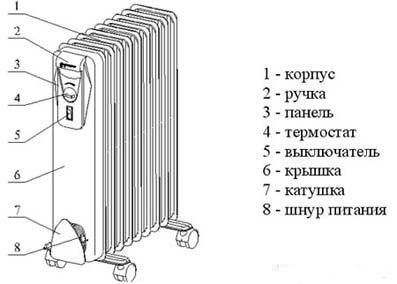

Oil heater device.
Oil heaters have been known to everyone since childhood. At one time, this was the most popular option for obtaining additional heat in the room. However, over the past decades, the situation has changed, and on the modern market there are various models of such equipment with more complex designs and increased operational safety indicators. It is the simplicity of the design that causes a large number of fakes or simply low-quality devices on the modern market. It is much easier to manufacture such a device than other types of heaters.
If desired, even a schoolboy who understands physics can make an oil heater. Therefore, it is better to go to a store with a good reputation for such a device, and not buy dubious imported equipment from hand. In addition to this basic rule of equipment selection, stick to two more.
First, pay attention to the labeling of the device. It should not raise the slightest doubt. Some counterfeiters simply print a brand name logo and paste it onto the box. Such markings immediately catch the eye and look very dubious.
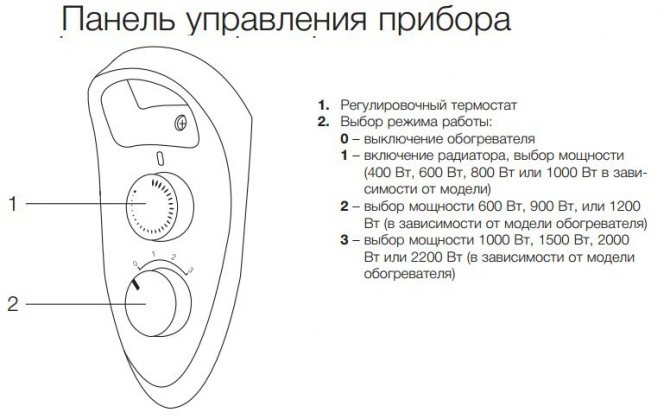

Oil heater control panel.
Secondly, when studying the operating instructions for the device, pay attention to its service life, which is indicated there. This is usually 5 or 7 years old. Longer periods are less common. Expect to use the heater for this period and not a day longer.
Otherwise, the likelihood that it will explode increases significantly. You shouldn't skimp on this equipment. This is fraught with large material losses in the event of a fire. A heater that has served you for the entire declared operational life must be discarded. Before that, it is recommended to damage it so that no one else has the opportunity to use a potentially dangerous device.
How to choose an oil-filled electric heater, which one is better
To choose a device, you need to consider:
- power;
- the size of the sections;
- weight;
- operating mode;
- functions;
- safety.
The choice of power is influenced by many factors, for example, whether the electric heater is the main heating element, in what temperature zone it will work, how quickly the room needs to be heated. For an approximate calculation, you can use a ratio of 1:10, 1 kW per 10 m².
The size of the sections is associated with inertia, weight. If the equipment has to be moved frequently, it is desirable that it be lighter, have handles with wheels. The additional power mode affects the heating speed. After heating, you can switch to economy mode by turning off the second spiral.
The energy-saving option is to use two low-power devices instead of one powerful one.
The functions include the use of a humidifier, dryer. If there is a wet cloth on the dryer, it will saturate the air well with steam. If there are children in the house, it is better to cover the heater with a protective cover.
Top heaters: ZANUSSI Nuovo ZOH / NV-11G, General Climate NY23LA, Royal Clima ROR-C7-1500M, etc.
How to prevent an explosion?
To prevent the heater from exploding, it is necessary to strictly adhere to the basic rules of its operation. Your own safety and the safety of your property depends on it. These rules are pretty simple and shouldn't take much effort on your part. So, the rules for the safe operation of such equipment are as follows:
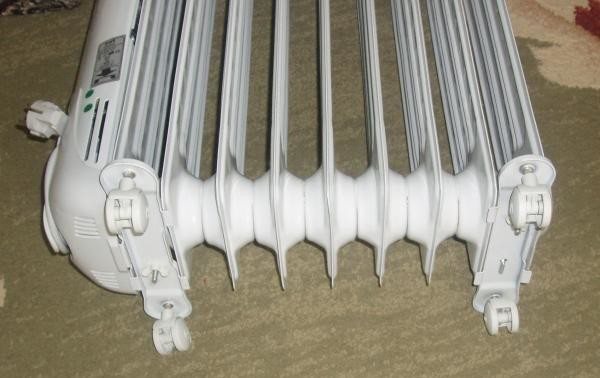

The oil heater must not be used in a horizontal position, otherwise it will overheat and cause an explosion.
- Do not use the device in a horizontal position. In this position, the equipment will instantly overheat. For such cases, a special thermostat is installed in the devices, which ensures their shutdown in case of overheating, but you should not tempt fate if it is possible to avoid dangerous situations.
- Do not leave the device unattended. This is especially true in cases where small children or pets live with you. They can inadvertently change the settings of the device or turn it over. In addition, children are more likely to burn themselves. The oil heater should only be operated under your supervision.
- After the summer season, when the device has not worked for a long time, it is imperative to check the health of its thermostat before starting operation. During such a test, the device should turn off when the operating temperature is reached. If this does not happen, then you cannot use the heater. It must be returned for repair or thrown away and purchased a new one. The serviceability of the thermal relay is very important for the safe use of an oil heater, since most of the unpleasant consequences from their incorrect operation are associated with overheating of the device.
- The device in which the leak has formed cannot be repaired. Theoretically, it can somehow be repaired, but at the same time, there will be less liquid inside the container with oil, since a significant part of the oil can leak out even through a slight damage to the case. How the equipment will work with the missing mineral oil is unknown. The heater may behave unpredictably during operation.
It should be remembered that no electrical device can be absolutely safe.However, there are safer options than oil heaters. The modern market for such equipment offers many alternatives, so if you are worried about your safety, it is advisable to opt for a more modern and unpretentious model in operation.
In any case, if you are using an oil heater, then you can avoid its explosion by following a few simple rules. Be careful and vigilant so that the heater in your home does not explode and damage your property, health or even life.
Why does the heater click
Sometimes clicks are heard when heating. May be due to water in oil. To eliminate it, it is necessary to unscrew the drain plug or heating element, drain the oil, evaporate the water. In bimetallic heaters, clicks occur due to the different thermal expansion of metals. Clicks are heard when thermostats are triggered, they use a bimetallic plate, when heated or cooled, it sharply changes shape.
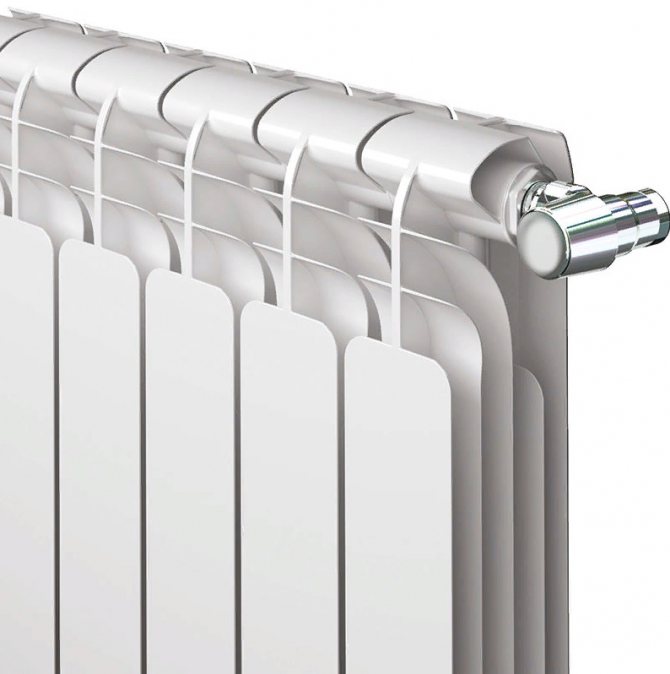

Bimetallic oil heater
Comparison of device parameters
To determine whether an oil or convector heater is better, you need to compare the technical parameters and other properties of the devices. This will allow you to make a choice in favor of one of the devices and not make a mistake when buying.
Warm-up time and energy consumption
The oil radiator requires additional time to heat the room, because its heating element first heats the oil, which then gives off its heat to the body, and only then does the direct heating of the air begin. As for the convector, it starts fulfilling its purpose immediately after being connected to the network. Because of this, the oil heater consumes more energy, and the convector is more economical.
But if you buy a radiator model equipped with a fan, the air warming up time will be significantly reduced. In addition, after disconnecting from the network, the oil device cools down much longer, respectively, the temperature in the room also does not drop so quickly.
Work safety
In a device with hot oil inside, the body is heated to a temperature of 90 ° C, and sometimes even higher. If not used carefully, it can cause burns. Families with small children should be especially careful. They can be advised to opt for a heater with a protective cover.
But also a radiator protected by a casing is not recommended to be left unattended, because if it accidentally falls, there is a high probability of overheating of the heating element, and as a result, the occurrence of a fire hazardous situation. Also, we must not forget that without a special device for drying clothes, it is forbidden to use the device for this purpose, because if the air access to the device is blocked, it can cause a fire.
The difference between the convector and the oil heater is that it is 100% safe. The temperature of its body under no circumstances will rise above 60 ° C, and in case of a fall, each such device is equipped with a special sensor that disconnects it from the network. The convector is allowed to be used even in bathrooms, which cannot be said about its rival.
Ease of use
The weight of the oil cooler is quite impressive: from 15 to 25 kg. Despite the castors, some effort is needed to move the device. The convector, on the other hand, weighs only about 10 kg, and is usually hung on the wall, where it does not cause any inconvenience. Some device models are also equipped with wheels and it is much easier to move them.
And also the convector heats the air much more evenlycreating a more comfortable environment. The same cannot be said for oil-based devices. After all, usually the air temperature near them is much higher.
Due to its appearance, the convector will perfectly fit into any environment and will not introduce dissonance into the surrounding atmosphere. And the oil can hardly be arranged so that it does not attract unnecessary attention.
Care and service life
In terms of maintenance of devices, an oil heater is much simpler. Its body needs to be wiped from dust from time to time, which does not take much time and effort. In the case of a convector, you should constantly monitor the condition of the holes through which the air circulates. If they become dirty, there may be problems with the operation of the device.
As for the service life of the device, the convector differs from the oil cooler in its longer service life. In the case of an oil-powered device, sooner or later microcracks appear, through which the contents flow out. Such a breakdown can no longer be eliminated.
Environmental friendliness and price
Both types of devices are distinguished by environmental safety... They do not burn oxygen, do not dry out the air and do not emit harmful substances. They can be safely used without fear of harm to health. But the cost of the convector is much higher, which can be explained by the higher quality. However, the low price of an oil cooler makes it more affordable and popular.
Thus, we can conclude that the convector in many respects outperforms the oil heater, but the final choice remains with the specific consumer. But despite the difference in some parameters, both devices cope with the task of heating the room.
Principle of operation
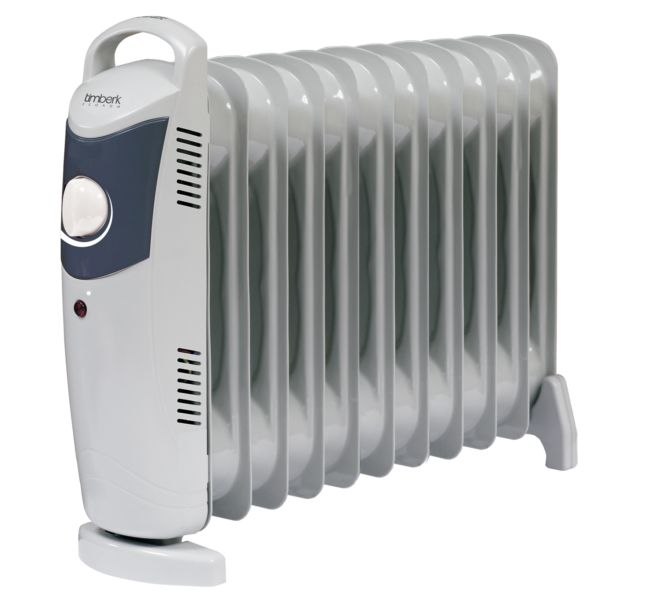

The oil heater consists of a metal body that visually resembles a stationary battery, special mineral oil and a heating element.
After connecting the device to the network, the heating element starts working, which heats the oil to the desired temperature. Further, the oil gives up its heat to the metal shell, which gradually heats up the surrounding air.
All modern models have several operating modes, thanks to which you can choose the intensity of heating the air in the room.
The built-in timer helps to regulate the temperature: at a given heating of the air, the device turns off, when it gets cold, it turns on.
Common malfunctions of an oil heater, their signs and repair methods
Eliminating a malfunction of an oil-filled electric heater, like repairing an infrared heater of any other type, requires certain skills and adherence to a number of rules.
Important! In the event of failure of any of the structural elements of the oil heater, the operation of the heater must be stopped until the malfunction is eliminated.
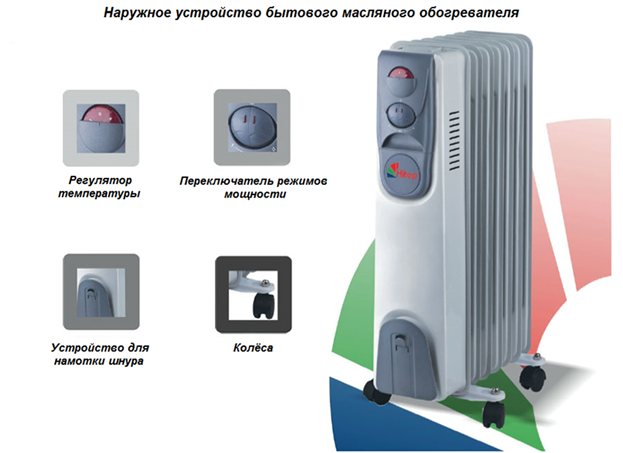

Actual image of one of the models of oil heaters with a list of outdoor equipment
First of all, one should be aware that restoring the operability of most of the components of this heating device at home is impossible or requires professional knowledge and skills. Experimenting with failed electrical components is fraught with unpredictable consequences (electrical injury, thermal injury, fire, explosion), therefore, repairing an oil heater with your own hands, without having professional training, in most cases should only be by replacing a worn-out part.
In addition, when repairing an electric heater, the following rules must be followed:
- the device must be unplugged from the socket;
- the heater must be cooled down to room temperature;
- equipping the device with homemade components is prohibited;
- contact of transformer oil with the body, as well as with the insulation of the wiring, should be avoided;
- it is prohibited to replace a standard mains cable with a grounding conductor with a wire without grounding.
Oil leak
The leakage of an oil cooler usually occurs when it is mechanically damaged or as a result of corrosion caused by a defect in the protective paintwork.
When a long-used, familiar oil radiator has flowed, a natural question arises, what to do, why not try to restore its tightness with your own hands?
However, repairing an infrared heater on your own in the event of a leak is possible only if the device is an old-style domestic-made unit with a flat steel radiator and a removable heating element.
Domestic oil-filled electric flat heaters with steel radiators
To carry out repairs, the control unit is disconnected from the device case, under which the heating element is located. Then, after disconnecting the contacts, the heater is unscrewed, and the oil is drained through the mounting socket into a clean container. The remaining oil is allowed to drain, after which the radiator is filled with water to prevent the oil from igniting inside it.
The wall thickness of such radiators is 1-1.2 mm, which allows the use of electric welding. The place of leakage on the body is cleaned with a grinder with a grinding disc or manually with coarse sandpaper. Depending on the location and size of the damage, a patch is cut out of steel of the appropriate thickness, applied to the hole and scalded with a Kemppi semiautomatic device.
Kemppi machines of various models for semi-automatic electric welding in the domestic environment
The weld is cleaned and ground, and then boiled again if necessary. After degreasing, the repair site is painted with a heat-resistant paint such as Rustins High Heat Black Pain.
Important! If the heater is painted using powder technology, then during the repair work you need to strive for minimal damage to the coating - it is impossible to restore it in domestic conditions.
Heat-resistant paint Rustins High Heat Black Pain in small packaging
After the paint has dried, the radiator is filled to 80% with oil and the heater is reassembled in the reverse order.
If the oil heater snapped during heating before the repair, you should not expect that the clicks will disappear after the tightness is restored - the mates of the housing parts are deformed when the temperature rises and at the same time crackle.
Repair of radiators of finned oil heaters is not advisable, since they are made of thin sheet steel using laser welding. Restoring the tightness of such tanks is technically difficult; in domestic conditions it does not guarantee success, or the cost is comparable to the cost of a new heater. In addition, if the heating element is non-removable, then the oil can be drained through damage, but it will no longer be possible to fill it back.
Lack of heating
A technically sound oil-filled domestic heater crackles quietly when plugged into the network. This factor is not dangerous, since it is caused only by the expansion of the prefabricated housing of the unit, which clicks when heated.
If, after turning on the unit and setting the required power and temperature values, the heater is silent, then the radiator does not heat up, and the malfunction should be looked for in the electrical part.
First of all, visually inspect the integrity of the electrical cable. If there is no visible damage, it is necessary to first dismantle the stands with wheels from the lower part of the unit housing.
Then you need to disconnect the control unit from the radiator, for which purpose a standard plate with the inscription Do not cover is pryed off and removed on top of it with a screwdriver, under which there are fastening screws.
Placement of fastening the screws of the control unit to the case
Having unscrewed the fasteners from above, in the lower part of the control unit, screws are also released or the fixing springs are unfastened (depending on the model), the shell is removed from the edge of the joint between the block and the radiator, and the dismantled unit is laid with the inside out.
The sequence of dismantling the control unit from the oil heater housing
They visually inspect the integrity of the wiring and insulation, as well as the quality of the contacts at the junction of the wires, paying attention to areas with kinks and oxidation.A wire with obvious internal damage is replaced with a new one, the oxidized contacts are disassembled, cleaned with sandpaper and reassembled.
At the end of the visual inspection, they begin to "dial" the components with the help of a tester - a multimeter, which begins with testing the cores of the wire section from the plug to the nearest connection. The operation is simplified by the different colors of the wires in the cable of the electrical appliance, which makes it easy to trace the direction of the wiring.
The audible signal of the tester indicates the integrity of the called section, the absence of a signal indicates damage.
The initial stage of dialing the oil heater with a multimeter - the section from the plug to the heating element
Replacing the tubular heater
The heating element, in addition to heating elements, is equipped with current and temperature fuses on the outside, the presence of which must be taken into account when dialing. The possibility of a situation is not excluded when, with a working heating element, one of these fuses burned out, or even both failed.
TENA fuses: on the left - by temperature, on the right - by current
If testing nevertheless revealed a failure of the tubular heater, then further actions depend on the method of installing the heating element in the radiator. The threaded fastening of the heater in the absence of rolling allows it to be replaced. In this case, the heating element is unscrewed from the radiator, and instead of it, with the replacement of the sealing gasket, a heater with identical parameters in terms of power and shutdown temperature is installed.
Tubular electric heater for threaded installation in a heating unit
In the case of a non-removable installation, the heater is sealed in the radiator socket. In domestic conditions, it is very difficult to flare the old one and install a new heating element by performing its airtight rolling, so you should think about buying a new oil heater.
Temperature controller malfunction
Testing this node is done as follows:
- ring out the section of the chain from the plug to the thermostat;
- the regulator is set to the minimum temperature value and tested - the circuit must be open;
- when each of the heaters is turned on separately, as well as two heating elements at the same time, when the temperature controller is set to a nonzero value, the circuit must be closed.
Inside view of the 2 kW Sinbo household oil heater thermostat
If the dialing of the thermostat showed its malfunction, that is, the oil heater does not respond to switching power modes or changing the temperature by turning the flywheel, the device must be replaced, since diagnostics of its technical characteristics followed by repairs based on the results of testing in an industrial environment is not advisable, but do this in living conditions is extremely difficult.
In the absence of faults, the regulator is cleaned of dust, and the contacts are tightened.
Failure of the bimetallic plate
The question of whether an oil heater can explode is relevant, since the oil pressure in the radiator reaches high values, and the air "cushion" in the form of 20% of its volume still has a limited potential. To prevent this from happening, there is a thermal relay in the heater design, which should turn off the heater in case of overheating.
Under normal conditions, this relay, which is a bimetallic plate, should close the electrical circuit. If the multimeter detects an open circuit in this thermal fuse, then it should also be replaced with a new one with identical characteristics.
Dial-up of the thermal relay of the oil-filled heater and the appearance of the thermal relay
Oil heaters explode extremely rarely, precisely because they have several degrees of protection, duplicating each other, and the likelihood of simultaneous failure of all safety devices is small.
No shutdown of the heater when overturning
The opening of the electrical circuit when the oil heater is tilted or overturned is ensured by a device whose principle of operation is based on the presence of a suspended weight in its structure, which retains its position when the unit deviates from the vertical.
Option of equipping an oil heater with a circuit breaker when the device is overturned - a plumb line with a metal weight
This device is tested by manually tilting the heater from the vertical. If the device does not turn off, the element must be cleaned of dust and disposed of, or better - replaced with a new one, the installation of which is not difficult.
It should be noted that if the safety switch fails, the oil heater does not explode - if the heating elements not covered with oil overheat, the thermal protection of the tubular heater is triggered, or the thermal relay opens the electrical circuit.

